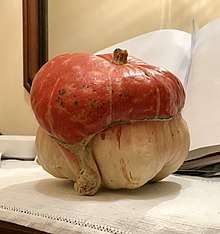Turban squash
Turban squash, also known as "Turk's turban" or "French turban" ("Giraumon" in French), is a type of squash most often used as a winter squash. It is an heirloom, predating 1820.[2] A cultivar of Cucurbita maxima, it is closely related to the buttercup squash.[3] It is typically 6 pounds when mature.[2] Colors vary, but are often mottled in shades of orange, green, and white.[3] The squash is used as both a vegetable and as an ornamental gourd.[4][5] Taste is similar to other C. maxima cultivars, though "not as vibrant,"[4] "reminiscent to hazelnut,"[3] and "coarse, watery and insipid."[6] Known in the nineteenth century as "the most beautiful in color, and the most worthless in quality, of all the varieties of squash;"[6] More recently, Ian Knauer, author of "The Farm", has described it as "nutty and sweet".[7]
| Cucurbita maxima 'Turban' | |
|---|---|
 Turban squash (variety Mini red turban) | |
| Species | Cucurbita maxima |
| Cultivar | Turban, Mini red turban |
| Origin | Northeastern United States[1] |
Two variety or cultivars:
- Turk's turban: a medium size tricolor gourd with red cap and red, green and white turban.
- Mini red turban: a small size bicolor gourd with red cap and white turban (sometimes with narrow red stripes). Like a mushroom.
References
- Andersen, Craig. "Summer Squash" (PDF). Home Gardening Series. University of Arkansas Agricultural Extension. Retrieved 16 May 2013.
- Schrager, Victor (2004). The Compleat Squash. Artisan Books. p. 61.
- Stradley, Linda. "Types of winter squash - The most popular winter squash varieties available". What's Cooking America. Retrieved 15 May 2013.
- Sharrard, Jesse (2 November 2006). "Super winter squash is not as tough as it seems". Pittsburgh Post-Gazette. Retrieved 15 May 2013.
- Wyman, Donald (1986). Wyman's Gardening Encyclopedia. Scribner. p. 277.
- Gregory, James J. H. (1893). Squashes: How to Grow Them. Marblehead, Mass.: James J.H. Gregory. p. 48.
french turban.
- Meatless Mondays: Roasted Turk’s Turban Squash and Onions With Tahini Dressing
